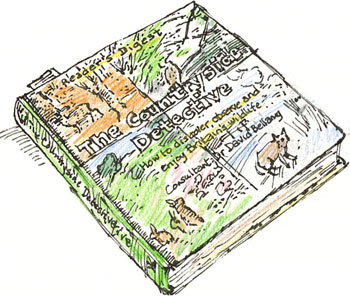The Countryside Detective
Richard Bell's Wild West Yorkshire Nature Diary, Wednesday, 30th June 2010
previous | home
page | this month | e-mail
richard | next
 I'M
A GREAT FAN of big glossy books about British wildlife; my latest is the stunningly
designed Dorling Kindersley/RSPB Wildlife of Britain; the Definitive Visual
Guide (2008) - the book equivalent of widescreen television - a sumptuous
tour of habitats, while, going back to 1973 to my student days, the AA Book
of the British Countryside went for as an A to Z encyclopedic format. I
tried to make it even more comprehensive by stuffing newspaper articles, postcards
and leaflets in the appropriate sections of the book, a sign of my enthusiasm
for the book and for my studies in natural history. It was an inspiration to
me, a benchmark to attempt to achieve in my ambitious student project A
Sketchbook of the Natural History of the Country Round Wakefield.
I'M
A GREAT FAN of big glossy books about British wildlife; my latest is the stunningly
designed Dorling Kindersley/RSPB Wildlife of Britain; the Definitive Visual
Guide (2008) - the book equivalent of widescreen television - a sumptuous
tour of habitats, while, going back to 1973 to my student days, the AA Book
of the British Countryside went for as an A to Z encyclopedic format. I
tried to make it even more comprehensive by stuffing newspaper articles, postcards
and leaflets in the appropriate sections of the book, a sign of my enthusiasm
for the book and for my studies in natural history. It was an inspiration to
me, a benchmark to attempt to achieve in my ambitious student project A
Sketchbook of the Natural History of the Country Round Wakefield.
The Countryside Detective (Reader's Digest, 2000), which
I'm currently reading, must rate as one of the most approachable of large format
natural histories because, instead of being written as a habitat-based field
guide or an encyclopedia of country lore, it presents natural history as observations
that you can use as the basis for detective work. It really makes you feel that
you could go out and discover things and understand how details fit into a wider
picture.
For instance, in the summer meadows sections there's a double-page
spread on cowpats and their ecology; the insects, birds and mammals associated
with them. Who would have thought that cowpats could be so interesting?
previous | home
page | this month | e-mail
richard | next
 I'M
A GREAT FAN of big glossy books about British wildlife; my latest is the stunningly
designed Dorling Kindersley/RSPB Wildlife of Britain; the Definitive Visual
Guide (2008) - the book equivalent of widescreen television - a sumptuous
tour of habitats, while, going back to 1973 to my student days, the AA Book
of the British Countryside went for as an A to Z encyclopedic format. I
tried to make it even more comprehensive by stuffing newspaper articles, postcards
and leaflets in the appropriate sections of the book, a sign of my enthusiasm
for the book and for my studies in natural history. It was an inspiration to
me, a benchmark to attempt to achieve in my ambitious student project A
Sketchbook of the Natural History of the Country Round Wakefield.
I'M
A GREAT FAN of big glossy books about British wildlife; my latest is the stunningly
designed Dorling Kindersley/RSPB Wildlife of Britain; the Definitive Visual
Guide (2008) - the book equivalent of widescreen television - a sumptuous
tour of habitats, while, going back to 1973 to my student days, the AA Book
of the British Countryside went for as an A to Z encyclopedic format. I
tried to make it even more comprehensive by stuffing newspaper articles, postcards
and leaflets in the appropriate sections of the book, a sign of my enthusiasm
for the book and for my studies in natural history. It was an inspiration to
me, a benchmark to attempt to achieve in my ambitious student project A
Sketchbook of the Natural History of the Country Round Wakefield.